遗传算法求解动态规划
数学模型最优化方法实现

数学模型最优化方法实现数学建模最优化方法是将数学建模问题转化为数学模型,并通过数学方法求解最优解的过程。
最优化方法在数学建模中起着非常重要的作用,可以帮助我们解决各种复杂的实际问题。
本文将介绍最优化方法的实现过程,并详细讨论最优化方法的几种常见算法。
最优化方法的实现过程主要分为以下几个步骤:建立数学模型、寻找最优解算法、编写程序实现、求解并分析结果。
首先,我们需要根据实际问题建立数学模型。
数学模型是问题的抽象表示,通常包括目标函数、约束条件和变量等要素。
通过合理地选择目标函数和约束条件,可以将问题转化为数学形式,便于后续的分析和求解。
其次,我们需要根据模型选择适当的最优解算法。
最优化方法有很多种,根据具体问题的特点和求解要求,我们可以选择不同的算法来求解最优解。
然后,我们需要编写程序将数学模型和求解算法实现。
编写程序是最优化方法实现的核心步骤,通过编写程序,我们可以自动化地求解最优化问题,并得到最优解。
最后,我们需要进行求解和结果分析。
通过求解模型并分析结果,可以验证模型的合理性,并根据结果调整模型或改进算法,以得到更好的最优解。
在实际应用中,根据问题的特点和求解需求,我们可以选择不同的最优化方法。
常见的最优化方法有:线性规划、非线性规划、整数规划、动态规划、遗传算法等。
下面将分别介绍这几种方法的原理和实现过程。
线性规划是最常用的最优化方法之一,适用于目标函数和约束条件都是线性的情况。
线性规划的基本思想是将问题转化为求解一个线性函数在约束条件下的最大值或最小值。
线性规划的求解算法有很多,例如单纯形法、内点法和对偶法等。
这些算法都是基于线性规划的特点和数学性质,通过迭代求解来逼近最优解。
实现线性规划方法的主要步骤包括:建立数学模型、选择适当的算法、编写相应的程序、求解并分析结果。
非线性规划是另一种常见的最优化方法,适用于目标函数或约束条件中包含非线性项的情况。
非线性规划的求解相对复杂,通常需要使用迭代算法来逼近最优解。
多组不相邻问题的处理方法

多组不相邻问题的处理方法多组不相邻问题的处理方法在实际生活中,我们经常会遇到多组不相邻问题,这些问题需要我们寻找合适的解决方法。
本文将从多个方面介绍如何处理多组不相邻问题。
一、定义多组不相邻问题多组不相邻问题是指在一个集合中有若干个元素,这些元素之间有一定的关系,但是不能同时选择某些特定的元素。
例如,在一个班级中,学生们需要选修两门课程,但是这两门课程不能同时选修。
这就是一个典型的多组不相邻问题。
二、处理方法1.贪心算法贪心算法是一种常用的解决多组不相邻问题的方法。
它通过每次选择当前最优解来得到全局最优解。
例如,在上述班级选课问题中,我们可以先按照每门课程的人数排序,然后从人数最少的课程开始选取,直到选完两门为止。
2.动态规划算法动态规划算法也可以用来解决多组不相邻问题。
它通过将大问题分解成小问题,并保存子问题的结果来得到全局最优解。
例如,在一个序列中找出最大和子序列时,可以使用动态规划算法。
3.回溯算法回溯算法是一种递归算法,可以用来解决多组不相邻问题。
它通过尝试所有可能的解,并回溯到上一个状态来得到全局最优解。
例如,在一个图中找出所有的哈密顿回路时,可以使用回溯算法。
4.分支界限算法分支界限算法也可以用来解决多组不相邻问题。
它通过将问题分成若干个子问题,并对每个子问题进行搜索,直到找到最优解为止。
例如,在一个图中找出最短路径时,可以使用分支界限算法。
5.遗传算法遗传算法是一种模拟自然选择的优化方法,可以用来解决多组不相邻问题。
它通过模拟生物进化过程中的基因交叉和变异来得到全局最优解。
例如,在一个图中找出最小生成树时,可以使用遗传算法。
三、实例演示为了更好地说明如何处理多组不相邻问题,下面以班级选课为例进行实例演示。
假设有一个班级,其中有6门课程可供选择:A、B、C、D、E、F。
每个学生需要选修两门课程,并且这两门课程不能同时选修。
现在需要确定每个学生应该选哪两门课程才能使得选课人数最少。
1.贪心算法首先按照每门课程的人数从小到大排序,得到以下结果:A:10人B:12人C:15人D:18人E:20人F:25人然后从人数最少的课程开始选取,直到选完两门为止。
决策优化方法

决策优化方法在当今信息爆炸的社会中,决策是各个领域中不可或缺的环节。
无论是企业管理、政策制定,还是个人生活中的抉择,决策都直接关系到成败与否。
因此,如何有效地进行决策就成为了研究的焦点。
随着计算机科学和数学的发展,决策优化方法应运而生,极大地提高了决策的准确性和效率。
本文将介绍以下几种主要的决策优化方法:线性规划、整数规划、动态规划和遗传算法。
一、线性规划线性规划是一种基于线性数学模型的最优化方法。
它的决策变量和目标函数都是线性的,并且满足一定的约束条件。
线性规划在管理、经济学和运筹学等领域具有广泛的应用。
通过确定目标函数和约束条件,并结合线性规划算法,可以求得最优解,从而做出最佳决策。
线性规划方法简单有效,但对于非线性问题的处理能力有限。
二、整数规划整数规划是线性规划的一种扩展形式,在决策变量中引入了整数约束条件。
整数规划可以更准确地刻画现实世界中的问题,并且适用范围更广。
在许多实际问题中,决策变量只能取整数值,比如生产批量、货物配送路线等。
整数规划求解复杂度较高,需要采用专门的算法和工具进行求解。
但整数规划方法能够提供更可行、更实际的解决方案。
三、动态规划动态规划是一种寻找最优决策序列的方法,适用于问题具有重叠子问题和最优子结构的情况。
动态规划通过将原问题分解为一系列子问题,并利用子问题的最优解来构造原问题的最优解。
动态规划方法通常用于具有多阶段、多决策的问题,比如资源分配、项目管理等。
动态规划方法能够充分利用已知信息,避免重复计算,从而提高决策的效率。
四、遗传算法遗传算法是一种模拟自然生物进化过程的启发式搜索方法。
它通过模拟自然选择、遗传变异和交叉等操作,生成新的解,并通过适应度函数评估解的适应性。
遗传算法可以应用于多种决策问题,特别适合于复杂的优化问题。
遗传算法方法具有良好的全局搜索能力和较强的鲁棒性,但求解过程较为复杂,需要充分考虑问题的特点和约束条件。
在实际应用中,根据问题的特点和需求,可以综合运用以上几种决策优化方法,以获得更好的决策结果。
基于遗传算法的规划问题求解
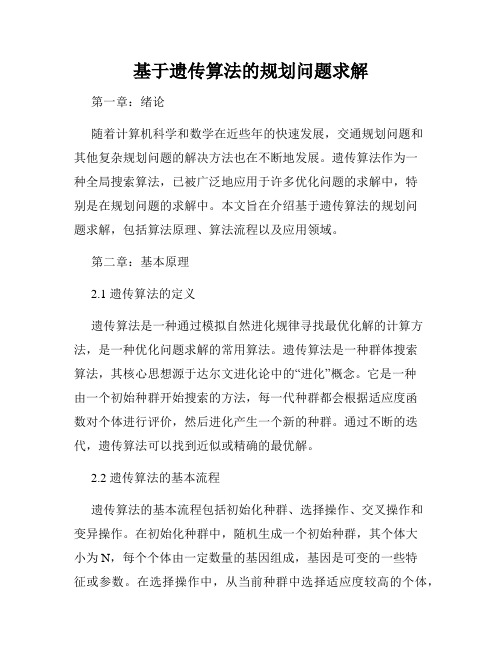
基于遗传算法的规划问题求解第一章:绪论随着计算机科学和数学在近些年的快速发展,交通规划问题和其他复杂规划问题的解决方法也在不断地发展。
遗传算法作为一种全局搜索算法,已被广泛地应用于许多优化问题的求解中,特别是在规划问题的求解中。
本文旨在介绍基于遗传算法的规划问题求解,包括算法原理、算法流程以及应用领域。
第二章:基本原理2.1 遗传算法的定义遗传算法是一种通过模拟自然进化规律寻找最优化解的计算方法,是一种优化问题求解的常用算法。
遗传算法是一种群体搜索算法,其核心思想源于达尔文进化论中的“进化”概念。
它是一种由一个初始种群开始搜索的方法,每一代种群都会根据适应度函数对个体进行评价,然后进化产生一个新的种群。
通过不断的迭代,遗传算法可以找到近似或精确的最优解。
2.2 遗传算法的基本流程遗传算法的基本流程包括初始化种群、选择操作、交叉操作和变异操作。
在初始化种群中,随机生成一个初始种群,其个体大小为N,每个个体由一定数量的基因组成,基因是可变的一些特征或参数。
在选择操作中,从当前种群中选择适应度较高的个体,将它们复制到下一代中。
在交叉操作中,从当前种群中选择适应度较高的个体进行配对,并随机选取一些交叉位点进行交叉,产生新的个体。
在变异操作中,对新产生的个体进行随机变异,以增加搜索空间。
2.3 遗传算法的适应度函数适应度函数是判断一组解的优劣的函数。
它通常用于比较个体之间的竞争力和选择潜力。
适应度函数的作用是将个体目标函数的值转换为相对适应度概率的评价函数。
适应度函数的取值通常在[0,1]之间,适应度高的个体在下一代中会被选中。
第三章:规划问题的求解3.1 规划问题的定义规划问题是一种优化问题,涉及到设计或制定决策以达到目标。
这些决策通常涉及资金、时间、资源或其他限制条件,例如城市规划、运输网络、验收计划等。
3.2 规划问题的建模在规划问题的求解中,需要将问题转化为数学模型,并根据问题设置目标函数。
这个目标函数通常用于评估各种备选方案的质量,并选择出最佳方案。
基于遗传算法的可重配置系统动态规划和管理
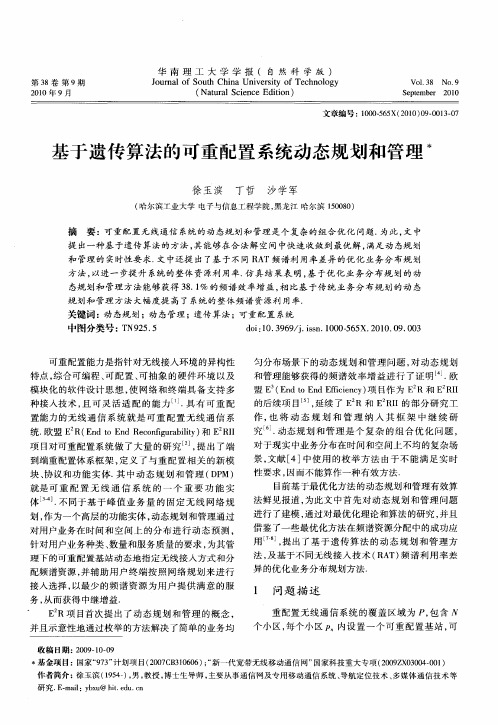
匀分 布 场景下 的 动态 规 划 和 管 理 问题 , 动态 规 划 对
和管 理 能够获 得 的频 谱 效率 增益 进 行 了证 明 J 欧 .
盟 E ( n n fcec ) 目作 为 E R和 E RI E dt E dE i y 项 o i n I 的后 续项 目 , 延续 了 E R和 E R I I 的部 分研 究 工
( trl c n eE io ) Na a S i c dt n u e i
文章编号 : 0055 2 1 )90 1-7 10 —6 X(0 0 0 —0 30
基 于 遗传 算 法 的可 重 配置 系统 动 态 规 划 和 管 理 术
徐 玉滨 丁哲 沙学军
( 尔 滨 工 业 大 学 电子 与 信 息 工 程 学 院 , 龙 江 哈 尔 滨 10 8 ) 哈 黑 50无 线 通 信 系
统. 欧盟 E R( n n eof ua it ) E R I E dt E dR cni rbly 和 I o g i
作 , 将 动 态 规 划 和 管 理 纳 人 其 框 架 中 继 续 研 也 究 J 动态 规 划 和 管 理 是 个 复 杂 的 组 合 优 化 问题 , .
可 重配 置能 力是 指针 对无 线接 人环境 的异构性 特 点 , 合 可编程 、 配置 、 综 可 可抽 象 的硬 件 环 境 以及 模块 化 的软件 设 计 思想 , 网络 和终 端 具 备 支持 多 使
种 接人 技术 , 可 灵 活 适 配 的 能 力 ¨ . 有 可 重 配 且 具
对于 现实 中业 务分 布在 时 间和空 间上不 均 的复杂场 景, 献[ ] 文 4 中使 用 的枚 举 方 法 由于不 能 满 足 实 时
组合优化的算法及应用

组合优化的算法及应用组合优化是指在一定条件下,寻找最优解的过程。
这种最优化过程往往涉及到很多方面,如经济、物流、资源分配等问题。
在这些问题中,需要找出最佳的、最优化的解决方法,以达到最大化收益或利益的目的。
在组合优化的问题中,我们往往需要通过特定的算法来解决问题。
今天,我们将重点介绍一些常用的组合优化算法及其应用。
这些算法包括贪心算法、回溯算法、动态规划、分支定界、遗传算法等。
下面,我们将逐一深入地讨论它们的原理和应用。
1. 贪心算法贪心算法是一种简单,高效的求解最优化问题的方法,这种算法在针对某些问题时能够提供最优解,但并不保证在所有情况下都能实现最优化。
贪心算法是建立在优化子结构性质的基础上的。
具有这种特性的问题的最优解可以通过一些局部的最优决策来达到,而这些最优决策的组合是达到最终最优解的必要条件。
贪心算法的应用十分广泛,例如贪心算法可以用于动态规划的预处理过程中,也可以用于另一个组合优化算法——分支定界中的剪枝。
2. 回溯算法回溯算法是一种试错的算法,可以解决诸如组合优化问题的一些计算问题。
在回溯过程中需要遵守很多约束条件,当然约束条件在不同问题中不尽相同。
在回溯算法的运行过程中,可能会多次出现重复计算的情况,因此,将动态的记录每个元素的状态是一个可行的方案。
回溯算法是N皇后问题的一种常见解法,也是很多非确定算法的重要组成部分。
3. 动态规划动态规划是一种常见的组合优化算法,常常用于解决最优化问题。
这种算法需求满足一些特定的条件,比如具有重叠子问题性质和无后效性。
如若满足这些条件,动态规划算法能够得出最优解。
动态规划的应用场景极广,例如: 背包问题、最长公共子序列问题、最大子段和问题、最短路径问题、最优搜索二叉树问题等。
4. 分支定界分支定界算法是一种求解离散数学问题的有效算法,和回溯算法有很多无法分割的相似之处。
分支定界算法在许多情况下被用来解决最优化问题。
在这种算法中,设定一个上下界,然后不停地进行二分查找以及例行 subtractive processing 的过程,以取得更好的优化结果,并将问题进一步细化。
货车配载问题的模型优化

货车配载问题的模型优化随着物流业的发展,货运车队的规模也不断地扩大。
对于货车而言,货物的配载是一项非常重要的环节。
关于货车配载问题,我们通常希望在保证货车最大化载量前提下,尽量减少货车运行中的重载与轻载情况,从而提高货运效率。
因此,货车配载问题的模型优化就显得尤为重要。
一、货车配载问题的建模与求解货车配载问题是一个典型的组合优化问题。
对于一辆货车,可以搭载多个货柜,每个货柜有不同的体积和重量限制,并且货物需要保证配载平衡。
因此,需要通过数学模型来描述完整的货车配载问题。
在将货车配载问题进行建模时,需要考虑以下几个因素:1.货车容量和限制。
2.货柜数量和容量。
3.货柜的载重限制。
4.货物的重量和空间占比等等。
基于这些因素,我们可以利用数学公式来描述货车配载问题的优化模型。
例如,可以采用整数规划或者线性规划模型求解货车配载问题。
这些模型都可以通过计算机算法进行求解,所以对于大规模的货车配载问题,可以在短时间内完成求解。
在模型优化中,我们通常会对货车配载问题的优化目标进行设定。
例如,如果我们希望最大化货车的载量,可以通过将货车容量视为优化目标的限制条件,从而让模型在保证最大化载量的同时,找到最优配载方案。
另外,如果我们希望在保证货车载量达到最大值的情况下,尽量减少货车重载和轻载的情况,可以将这些约束条件考虑在内,并对模型进行进一步的优化。
二、常见的货车配载问题的解决方法1.贪心算法贪心算法是一种简单有效的解决货车配载问题的算法。
它的核心思想是每一次选择在当前情况下看起来最好的决策,并逐步构建出一个最终的解决方案。
例如,对于货车配载问题,可以将货柜按照重量或者体积进行排序,然后依次选择符合要求的货柜进行配载。
这种算法对于小规模的货车配载问题有一定的优势,但是对于大规模问题的解决效率则会降低。
2.动态规划算法动态规划算法是一种较为复杂的算法,它的核心思想是将大问题分解成小问题,并利用小问题的最优解来构建一个全局的最优解。
组合优化问题的算法与求解

组合优化问题的算法与求解组合优化问题是一类需要在给定的约束条件下找到最优解的问题。
这些问题在现实生活中有着广泛的应用,比如物流配送问题、旅行商问题等等。
本文将介绍几种常见的组合优化问题的算法以及它们的求解方法。
一、贪婪算法贪婪算法是一种简单而高效的求解组合优化问题的方法。
它通过在每一步选择当前看起来最优的解决方案,逐步建立起最终的解。
贪婪算法通常具有快速的执行速度和较好的近似解质量。
例如,对于旅行商问题,贪婪算法可以从一个起点开始,每次选择离当前位置最近的未访问节点作为下一个访问节点,直到所有节点都被访问过。
这样,贪婪算法可以得到一个近似的最短路径。
二、回溯算法回溯算法是一种穷举搜索的方法,它通过逐个尝试所有可能的解决方案,并逐步剪枝以减少搜索空间。
回溯算法通常适用于组合优化问题的求解,尤其是在问题规模较小的情况下。
以0-1背包问题为例,回溯算法可以通过穷举所有可能的物品选择方式,计算其总价值,并在搜索过程中剪枝以提高效率。
回溯算法的优势在于能够找到最优解,但在问题规模较大时,耗时较长。
三、动态规划算法动态规划算法是一种将问题分解为子问题并记录子问题结果的方法。
它适用于能够将原问题分解为相互重叠的子问题,并利用子问题的解来推导原问题的解。
比如在背包问题中,动态规划算法可以通过定义状态转移方程来解决。
设dp[i][j]表示在前i个物品中选择总重量不超过j的情况下的最大价值,则有以下状态转移方程:dp[i][j] = max(dp[i-1][j], dp[i-1][j-w[i]] + v[i])通过填表计算,可以获得最终的最优解。
四、遗传算法遗传算法是一种模拟自然选择和遗传机制的搜索算法。
它通过模拟生物种群的遗传、变异、选择等过程,逐步演化出最优解。
遗传算法在求解组合优化问题时,通过编码将解空间中的解表示成染色体,并利用交叉、变异等遗传操作来搜索更优的解。
通过不断迭代,遗传算法能够找到较好的解,但无法保证找到全局最优解。
离散优化问题及其求解技术

离散优化问题及其求解技术离散优化问题在现实生活中广泛存在,涉及到资源分配、路线规划、任务调度等众多领域。
通过使用合适的求解技术,我们可以有效地解决这些优化问题。
本文将介绍离散优化问题的基本概念和常见求解技术,旨在帮助读者提升对该领域的理解和应用能力。
一、离散优化问题概述离散优化问题是指在一组有限选择中,寻找最优解的问题。
与连续优化问题相比,离散优化问题的解空间是离散的。
离散优化问题通常可以形式化为一个数学模型,其中包含目标函数和一系列约束条件。
离散优化问题可以分为线性规划、整数规划、组合优化等不同类型。
线性规划是指目标函数和约束条件均为线性的优化问题;整数规划是指变量的取值只能是整数的优化问题;而组合优化则是指在离散集合中寻找最优解的问题。
二、离散优化问题的求解技术1. 枚举法枚举法是一种简单直观的求解技术,它通过枚举所有可能的解来找到最优解。
枚举法的优点是能够确保找到最优解,缺点是对于大规模问题,耗时较长。
2. 贪婪算法贪婪算法是一种基于当前最优选择来进行决策的求解技术。
在每一步中,贪婪算法选择当前最优的解,并逐步构建最终解。
贪婪算法的优点是简单高效,缺点是不能保证找到全局最优解。
3. 动态规划动态规划是一种将问题分解为子问题然后逐步求解的求解技术。
动态规划通过存储中间计算结果,避免了重复计算,以提高求解效率。
动态规划的优点是能够找到最优解,但对于问题规模较大的情况,计算复杂度较高。
4. 分支定界法分支定界法是一种通过不断减小解空间来寻找最优解的求解技术。
该方法将问题分解为一系列子问题,并通过剪枝操作来减小问题的规模。
分支定界法的优点是能够找到最优解,并且计算复杂度相对较低。
5. 遗传算法遗传算法是一种模拟生物进化过程的求解技术。
该方法通过使用基因编码和选择、交叉、变异等遗传操作来搜索解空间,并通过适应度函数评估解的质量。
遗传算法的优点是能够处理高维、非线性问题,但对于问题的选择和参数的设置较为敏感。
优化算法的分类

优化算法的分类优化算法是一种用于找到问题的最优解或近似最优解的方法。
在计算机科学和运筹学领域,优化算法被广泛应用于解决各种实际问题,例如机器学习、图像处理、网络设计等。
优化算法的分类可以根据其基本原理或应用领域进行划分。
本文将介绍一些常见的优化算法分类。
1. 传统优化算法传统优化算法是指早期开发的基于数学原理的算法。
这些算法通常基于确定性模型和数学规则来解决问题。
以下是一些常见的传统优化算法:(1) 穷举法穷举法是一种朴素的优化算法,它通过遍历所有可能的解空间来寻找最优解。
穷举法的优点是能够找到全局最优解(如果存在),缺点是搜索空间过大时会非常耗时。
(2) 贪婪算法贪婪算法是一种启发式算法,它通过每一步选择当前状态下最优的决策,从而逐步构建最优解。
贪婪算法的优势是简单快速,但它可能无法找到全局最优解,因为它只考虑了当前最优的选择。
(3) 动态规划动态规划是一种基于最优子结构和重叠子问题性质的优化算法。
它将原问题拆分为一系列子问题,并通过保存子问题的解来避免重复计算。
动态规划的优点是可以高效地求解复杂问题,例如最短路径问题和背包问题。
(4) 分支界限法分支界限法是一种搜索算法,它通过不断分割搜索空间并限制搜索范围,以找到最优解。
分支界限法可以解决一些组合优化问题,如旅行商问题和图着色问题。
2. 随机优化算法随机优化算法是基于概率和随机性的算法,通过引入随机扰动来逐步寻找最优解。
以下是一些常见的随机优化算法:(1) 模拟退火算法模拟退火算法模拟了固体物体冷却过程中的原子运动,通过逐步减小随机扰动的概率来搜索最优解。
模拟退火算法可以通过接受劣解来避免陷入局部最优解。
(2) 遗传算法遗传算法模拟了生物进化过程,通过遗传操作(如交叉和变异)来搜索最优解。
遗传算法通常包括种群初始化、选择、交叉和变异等步骤,能够自适应地搜索解空间。
(3) 蚁群算法蚁群算法模拟了蚂蚁在寻找食物时的行为,通过蚂蚁之间的信息交流和挥发性信息素来搜索最优解。
计算机网络优化算法

计算机网络优化算法计算机网络优化算法(Computer Network Optimization Algorithms)是指通过使用数学、统计学和计算机科学的方法来优化计算机网络系统的性能和效率。
这些算法的设计主要是为了最大化网络资源的利用率、最小化网络延迟和最优化网络吞吐量。
本文将介绍几种常见的计算机网络优化算法,包括贪心算法、动态规划算法、遗传算法和禁忌搜索算法等。
1. 贪心算法贪心算法是一种基于局部最优选择的算法,它每次在作出选择时都只考虑当前状态下的最优解。
在计算机网络中,贪心算法可以用于一些简单的网络优化问题,如最佳路径选择、带宽分配等。
贪心算法的优点是简单易实现,但缺点是可能会导致局部最优解而非全局最优解。
2. 动态规划算法动态规划算法是一种将复杂问题分解为简单子问题并存储中间结果的算法。
在计算机网络中,动态规划算法可以用于一些具有重叠子问题的优化问题,如最短路径问题、最小生成树问题等。
动态规划算法的优点是能够得到全局最优解,但缺点是其计算复杂度较高。
3. 遗传算法遗传算法是一种模拟生物进化过程的优化算法。
在计算机网络中,遗传算法可以用于解决一些复杂的优化问题,如网络布线问题、拓扑优化问题等。
遗传算法的优点是能够找到较好的全局最优解,但缺点是其计算复杂度高且需要大量的计算资源。
4. 禁忌搜索算法禁忌搜索算法是一种通过记录和管理搜索路径来避免陷入局部最优解的优化算法。
在计算机网络中,禁忌搜索算法可以用于解决一些带有约束条件的优化问题,如链路带宽分配问题、网络拓扑优化问题等。
禁忌搜索算法的优点是能够在可行解空间中进行有效搜索,但缺点是其计算复杂度较高且需要适当的启发式规则。
综上所述,计算机网络优化算法是一类用于改善计算机网络系统性能的关键算法。
选择合适的网络优化算法取决于具体的问题和限制条件。
贪心算法适用于简单的问题,动态规划算法适用于具有重叠子问题的问题,遗传算法适用于复杂的问题,禁忌搜索算法适用于带有约束条件的问题。
动态优化方法以及其应用

动态优化方法以及其应用动态优化是指解决系统动态运行过程中的最优化问题,它可以对系统进行在线调整,从而实现系统性能最优化。
在实际应用中,动态优化方法可以被广泛应用于各种系统优化中,例如,路由算法、资源调度、能耗管理等问题。
动态优化方法包括以下几个方面:动态规划、贪心算法、遗传算法和模拟退火算法等。
各种算法具有不同的优点和适用范围,根据具体的问题,我们选择不同的算法方法,并结合实际情况不断调整算法参数。
动态规划算法是目前应用最广泛的一种动态优化方法。
其原理在于分解问题为若干子问题,将问题的最优解逐步递推得到,最终得到总问题的解。
动态规划算法具有计算速度快、准确性高等优点,因此被广泛应用于路由算法、图像处理、语音识别等问题中。
贪心算法是一种通过贪心的方式逐步求得问题最优解的方法。
其原理在于,对问题进行分解,每次贪心地选择当前最优的选择。
贪心算法在空间优化方面比动态规划更具优势,但其结果并不一定是全局最优解,因此,它适用于一些局部最优化问题。
遗传算法是一种从自然界中得到的优化算法,其基本原理是仿照生物遗传变异、自然选择等基本规律进行求解。
遗传算法具有计算速度较快、能够得到局部最优解等特点,适合求解那些因为变量较多、导致求解困难的问题。
模拟退火算法是一种直观易于理解、求解效果也较为优异的算法。
其思维基础来源于固体物质的热力学原理,通过渐进降温的方式对问题进行求解,可以在求解过程中不断地跳出局部极小值点,大大提高了优化结果的准确性。
除了以上方法外,还有很多其他的优化算法,如粒子群算法、蚁群算法、神经网络等等,这些算法都是根据不同的问题背景和要求,进行选用和优化的。
以上算法优化方法都是针对单一问题进行优化的,当多个问题同时存在时,我们可以采用多目标优化方法。
多目标优化方法可以对多个问题进行统一的考虑和处理,得到系统最优解。
在实际应用中,动态优化方法可以被广泛应用于各种系统优化中,例如路由算法、图像处理、语音识别、机器学习、电力设备控制等领域中。
离散优化问题的求解方法

离散优化问题的求解方法离散优化问题是指在一组离散的决策变量中,寻找最优决策方案的问题。
这类问题广泛存在于社会经济、工程技术和科学研究中。
离散优化问题的求解方法包括贪心算法、动态规划、分支定界和遗传算法等。
本文将主要介绍这几种常用的离散优化问题求解方法。
一、贪心算法贪心算法是一种基于局部最优选择策略来构造全局最优解的算法。
它通过每次只考虑当前状态局部最优选择的策略来寻求全局最优解。
由于其简单易用和高效性质,在许多离散优化问题中得到了广泛应用。
贪心算法的缺点是可能无法得到全局最优解。
例如,在背包问题中,贪心算法的思路是每次选择价值最高的物品放进背包中。
但是,如果物品有一个较大的体积并且它的价值不高,则贪心算法可能会选择这个物品,导致放不下其他更有价值的物品。
因此,贪心算法并不一定能达到全局最优解。
二、动态规划动态规划是一种利用已找到的最优子问题来寻求全局最优解的算法。
动态规划通常用于具有重复子问题和最优子结构的问题。
动态规划的过程是先解决子问题,然后再利用子问题的解来解决更大的问题。
例如,在最长公共子序列问题中,动态规划的思路是先求出两个序列的最长公共子序列的长度,然后根据子问题的解求出更大的问题的解。
动态规划的优点是能够得到全局最优解。
但是,它需要存储大量的中间结果,导致算法开销较大。
三、分支定界分支定界是一种利用问题不等式或者限制条件,将解空间逐步分割成子集,并进一步对子集进行细分,以快速减少搜索解空间的算法。
它通常用于需要枚举所有可能解的问题,并试图在搜索过程中快速排除那些明显无法成为最优解的候选解。
通过剪枝操作,分支定界可以大大缩小搜索空间。
例如,在旅行商问题中,分支定界的思路是不断分割解空间,并剪枝去除那些无法成为最优解的分支。
分支定界的优点是能够快速找到全局最优解,但是对于复杂的问题,搜索空间的规模可能会非常大,导致算法的效率低下。
四、遗传算法遗传算法是一种受到了生物进化思想启发的优化算法。
TSP的几种求解方法及其优缺点
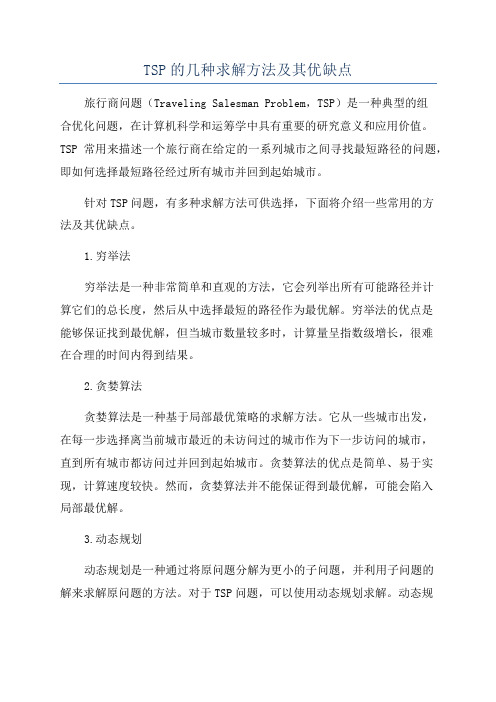
TSP的几种求解方法及其优缺点旅行商问题(Traveling Salesman Problem,TSP)是一种典型的组合优化问题,在计算机科学和运筹学中具有重要的研究意义和应用价值。
TSP常用来描述一个旅行商在给定的一系列城市之间寻找最短路径的问题,即如何选择最短路径经过所有城市并回到起始城市。
针对TSP问题,有多种求解方法可供选择,下面将介绍一些常用的方法及其优缺点。
1.穷举法穷举法是一种非常简单和直观的方法,它会列举出所有可能路径并计算它们的总长度,然后从中选择最短的路径作为最优解。
穷举法的优点是能够保证找到最优解,但当城市数量较多时,计算量呈指数级增长,很难在合理的时间内得到结果。
2.贪婪算法贪婪算法是一种基于局部最优策略的求解方法。
它从一些城市出发,在每一步选择离当前城市最近的未访问过的城市作为下一步访问的城市,直到所有城市都访问过并回到起始城市。
贪婪算法的优点是简单、易于实现,计算速度较快。
然而,贪婪算法并不能保证得到最优解,可能会陷入局部最优解。
3.动态规划动态规划是一种通过将原问题分解为更小的子问题,并利用子问题的解来求解原问题的方法。
对于TSP问题,可以使用动态规划求解。
动态规划的优点是能够在较短的时间内找到最优解,但由于需要存储大量的中间结果,空间复杂度较高。
4.遗传算法遗传算法是一种模拟生物进化过程的求解方法。
它通过对候选解进行遗传操作(交叉、变异等),然后根据适应度函数来评估和选择较好的解进行下一轮进化,直到满足停止条件为止。
遗传算法的优点是适用于大规模问题,能够得到较优解,但其需要调整一些参数,并且收敛速度较慢。
5. Lin-Kernighan启发式算法Lin-Kernighan启发式算法是一种基于局部优化的TSP求解方法。
它采用迭代的方式,在每一步通过反转局部路径来优化当前解,直到达到停止条件。
Lin-Kernighan算法的优点是计算速度较快,对于大规模问题也有较好的效果。
进化算法在动态规划中的优化应用

进化算法在动态规划中的优化应用动态规划是一种重要的数学方法,它可以用来解决各种实际问题。
很多复杂问题都可以被转化为动态规划模型,从而用动态规划来求解。
然而,由于动态规划的计算量很大,如果使用传统的算法进行计算,需要消耗很大的时间和空间资源。
为了解决这个问题,人们引入了进化算法来优化动态规划算法。
进化算法是一种基于自然进化原理的算法,它可以利用种群中的“优秀个体”来搜索“解空间”,并逐步逼近最优解。
和传统算法不同,进化算法不需要事先知道问题的解法,而是通过多次迭代,自动找到最优解。
进化算法在动态规划中的应用主要包括以下几个方面。
1. 基于粒子群算法的动态规划优化粒子群算法是一种比较常见的进化算法。
它通过模拟鸟群飞行的过程来搜索最优解。
在动态规划中,可以采用粒子群算法来对状态空间进行优化。
将“粒子”看作状态空间中的一个点,然后利用算法找到最优点,即可得到最优解。
2. 基于遗传算法的动态规划优化遗传算法是一种基于生命进化理论的进化算法。
它通过适应度函数来衡量个体的适应性,并通过“交叉”和“变异”等操作来实现种群的进化。
在动态规划中,可以利用遗传算法来对状态空间进行优化,从而得到更为优秀的解。
3. 基于蚁群算法的动态规划优化蚁群算法是一种模拟蚂蚁在寻找食物过程中产生的信息素作用的进化算法。
它通过“信息素”的传递和更新来实现不断搜索最优解的过程。
在动态规划中,可以采用蚁群算法来对状态空间进行优化,从而得到更为准确的最优解。
4. 基于模拟退火算法的动态规划优化模拟退火算法是一种基于物理学中退火原理的进化算法。
它通过控制温度和能量等参数,来模拟物理系统在退火过程中的状态变化。
在动态规划中,可以采用模拟退火算法来对状态空间进行优化,从而得到更为精确的最优解。
总之,进化算法在动态规划中的优化应用是一个不断发展和完善的领域。
通过对各种进化算法的评估和比较,可以选择最适合特定问题的算法,从而提高动态规划算法的效率和准确度。
数学建模常用算法模型

数学建模常用算法模型在数学建模中,常用的算法模型包括线性规划、整数规划、非线性规划、动态规划、图论算法以及遗传算法等。
下面将对这些算法模型进行详细介绍。
1.线性规划:线性规划是一种用于求解最优化问题的数学模型和解法。
它的目标是找到一组线性约束条件下使目标函数取得最大(小)值的变量取值。
线性规划的常用求解方法有单纯形法、内点法和对偶理论等。
2.整数规划:整数规划是一种求解含有整数变量的优化问题的方法。
在实际问题中,有时变量只能取整数值,例如物流路径问题中的仓库位置、设备配置问题中的设备数量等。
整数规划常用的求解方法有分支界定法和割平面法等。
3.非线性规划:非线性规划是一种求解非线性函数优化问题的方法,它在实际问题中非常常见。
与线性规划不同,非线性规划的目标函数和约束函数可以是非线性的。
非线性规划的求解方法包括牛顿法、拟牛顿法和全局优化方法等。
4.动态规划:动态规划是一种用于解决决策过程的优化方法。
它的特点是将问题划分为一系列阶段,然后依次求解每个阶段的最优决策。
动态规划常用于具有重叠子问题和最优子结构性质的问题,例如背包问题和旅行商问题等。
5.图论算法:图论算法是一类用于解决图相关问题的算法。
图论算法包括最短路径算法、最小生成树算法、网络流算法等。
最短路径算法主要用于求解两点之间的最短路径,常用的算法有Dijkstra算法和Floyd-Warshall算法。
最小生成树算法用于求解一张图中连接所有节点的最小代价树,常用的算法有Prim算法和Kruskal算法。
网络流算法主要用于流量分配和问题匹配,例如最大流算法和最小费用最大流算法。
6.遗传算法:遗传算法是一种借鉴生物进化原理的优化算法。
它通过模拟生物的遗传、变异和选择过程,不断优化问题的解空间。
遗传算法适用于对问题解空间有一定了解但难以确定最优解的情况,常用于求解复杂的组合优化问题。
总结起来,数学建模中常用的算法模型包括线性规划、整数规划、非线性规划、动态规划、图论算法以及遗传算法等。
组合优化问题的算法研究与应用

组合优化问题的算法研究与应用组合优化问题是指在某一条件下,从已知的一组元素中选取若干个元素,使这些元素之间满足某种规则,且符合某种最优化目标的问题。
在实际生活中,这些问题广泛应用于许多领域,如机器学习、经济学、运筹学、计算机科学等。
因此,研究与应用组合优化问题的算法成为了近年来的一个热点话题。
一、组合优化问题的分类组合优化问题可以分为NP问题和P问题两大类。
其中,P问题是指可以在多项式时间内进行计算的问题,而NP问题是指只能在指数时间内进行计算的问题。
二、组合优化问题的算法研究在组合优化问题的算法研究中,常用的算法有贪心算法、回溯算法、分支定界算法、动态规划算法、遗传算法等。
1、贪心算法贪心算法是指每次选择在某种意义下看起来最优的选择,即先求当前最优解。
因为贪心算法每次只考虑当前状态,所以复杂度较低。
但是,贪心算法也有其局限性,因为它只关注当前状态,而不会考虑未来可能的变化。
2、回溯算法回溯算法是基于深度优先搜索的思想,通过不断试错的方法,在搜索过程中扩展解空间,找到问题的最优解。
同时,回溯算法适用于解空间较小的组合优化问题。
3、分支定界算法分支定界算法是指通过对决策树进行搜索,找到解空间中最优的解。
算法将决策树分为多个子树,在子树内进行搜索,并通过对解的限定条件进行分支,最终找到最优解。
4、动态规划算法动态规划算法是指将大问题分解为多个小问题来解决,通过对小问题的解的组合,得到大问题的最优解。
动态规划算法适用于连续性的组合优化问题,其典型例子为背包问题。
5、遗传算法遗传算法是一种基于生命遗传学思想的优化算法,在优化过程中,模仿生物进化过程,通过优胜劣汰的选择方式,使优秀的个体逐步演化而来。
由于其鲁棒性和全局搜索能力,遗传算法被广泛应用于组合优化问题领域。
三、组合优化问题的应用场景在实际生活中,组合优化问题的应用场景非常广泛。
例如,在运输物流中,优化路径问题使得企业在最短时间内完成物流配送,提高效率;在社交网络中,优化社交关联度问题帮助用户快速找到相似兴趣爱好的人,加快交友速度;在机器学习中,优化分类精度问题为用户推荐更准确的商品等。
组合优化问题的求解算法和理论研究
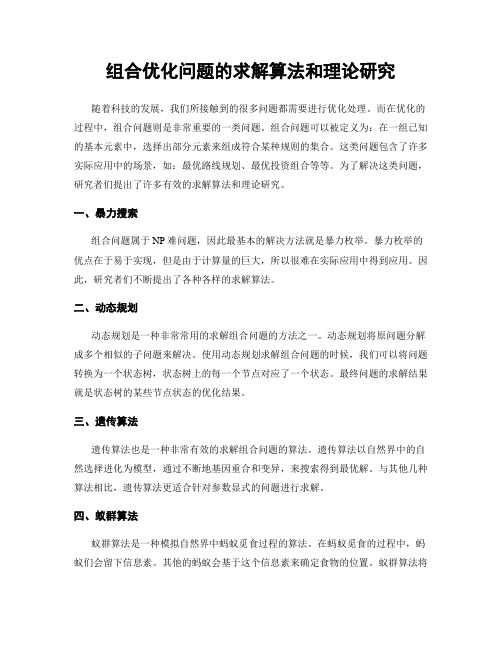
组合优化问题的求解算法和理论研究随着科技的发展,我们所接触到的很多问题都需要进行优化处理。
而在优化的过程中,组合问题则是非常重要的一类问题。
组合问题可以被定义为:在一组已知的基本元素中,选择出部分元素来组成符合某种规则的集合。
这类问题包含了许多实际应用中的场景,如:最优路线规划、最优投资组合等等。
为了解决这类问题,研究者们提出了许多有效的求解算法和理论研究。
一、暴力搜索组合问题属于NP难问题,因此最基本的解决方法就是暴力枚举。
暴力枚举的优点在于易于实现,但是由于计算量的巨大,所以很难在实际应用中得到应用。
因此,研究者们不断提出了各种各样的求解算法。
二、动态规划动态规划是一种非常常用的求解组合问题的方法之一。
动态规划将原问题分解成多个相似的子问题来解决。
使用动态规划求解组合问题的时候,我们可以将问题转换为一个状态树,状态树上的每一个节点对应了一个状态。
最终问题的求解结果就是状态树的某些节点状态的优化结果。
三、遗传算法遗传算法也是一种非常有效的求解组合问题的算法。
遗传算法以自然界中的自然选择进化为模型,通过不断地基因重合和变异,来搜索得到最优解。
与其他几种算法相比,遗传算法更适合针对参数显式的问题进行求解。
四、蚁群算法蚁群算法是一种模拟自然界中蚂蚁觅食过程的算法。
在蚂蚁觅食的过程中,蚂蚁们会留下信息素。
其他的蚂蚁会基于这个信息素来确定食物的位置。
蚁群算法将这个机制应用到组合问题中,用信息素来指导求解的过程。
蚁群算法通过模拟蚂蚁觅食的过程,来搜索得到最优解。
五、理论研究除了各种算法的应用外,理论研究对于组合问题的求解也是非常重要的。
在理论上,我们可以根据组合问题的性质,构建数学模型来分析问题的特征。
这些特征可以被应用到算法的设计和实现中,使得我们对应用场景的理解更为深刻,同时也能够更好地指导实践问题的求解。
总之,组合问题是一类非常重要的问题类型,处理好这类问题不仅可以在日常生活中节约时间和资源,还可以推动科学与技术的发展。
tsp问题有几种方案
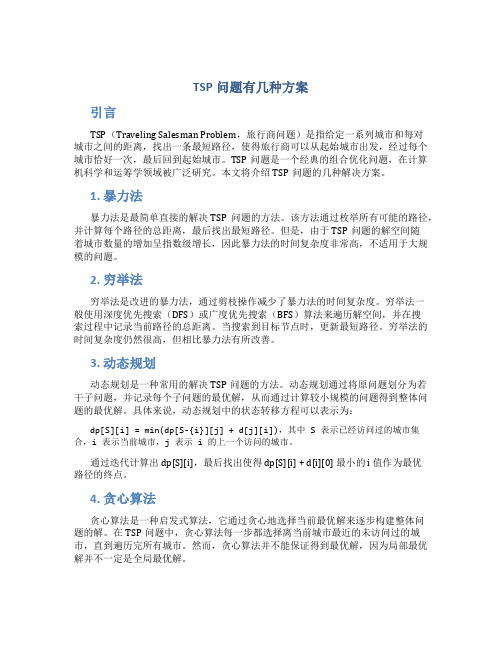
TSP问题有几种方案引言TSP(Traveling Salesman Problem,旅行商问题)是指给定一系列城市和每对城市之间的距离,找出一条最短路径,使得旅行商可以从起始城市出发,经过每个城市恰好一次,最后回到起始城市。
TSP问题是一个经典的组合优化问题,在计算机科学和运筹学领域被广泛研究。
本文将介绍TSP问题的几种解决方案。
1. 暴力法暴力法是最简单直接的解决TSP问题的方法。
该方法通过枚举所有可能的路径,并计算每个路径的总距离,最后找出最短路径。
但是,由于TSP问题的解空间随着城市数量的增加呈指数级增长,因此暴力法的时间复杂度非常高,不适用于大规模的问题。
2. 穷举法穷举法是改进的暴力法,通过剪枝操作减少了暴力法的时间复杂度。
穷举法一般使用深度优先搜索(DFS)或广度优先搜索(BFS)算法来遍历解空间,并在搜索过程中记录当前路径的总距离。
当搜索到目标节点时,更新最短路径。
穷举法的时间复杂度仍然很高,但相比暴力法有所改善。
3. 动态规划动态规划是一种常用的解决TSP问题的方法。
动态规划通过将原问题划分为若干子问题,并记录每个子问题的最优解,从而通过计算较小规模的问题得到整体问题的最优解。
具体来说,动态规划中的状态转移方程可以表示为:dp[S][i] = min(dp[S-{i}][j] + d[j][i]),其中 S 表示已经访问过的城市集合,i 表示当前城市,j 表示 i 的上一个访问的城市。
通过迭代计算出 dp[S][i],最后找出使得 dp[S][i] + d[i][0] 最小的 i 值作为最优路径的终点。
4. 贪心算法贪心算法是一种启发式算法,它通过贪心地选择当前最优解来逐步构建整体问题的解。
在TSP问题中,贪心算法每一步都选择离当前城市最近的未访问过的城市,直到遍历完所有城市。
然而,贪心算法并不能保证得到最优解,因为局部最优解并不一定是全局最优解。
5. 遗传算法遗传算法是一种演化算法,模拟生物进化的过程来寻找最优解。
供应链管理中的订单分配优化算法

供应链管理中的订单分配优化算法在现代商业运作中,供应链管理扮演着重要的角色。
供应链管理旨在通过优化供应链中的各个环节,提高整个供应链的效率和效益。
其中,订单分配是供应链管理中的关键环节之一,它涉及到将来自客户的订单分配给不同的供应商或分销商,以满足客户需求并最大化供应链的整体效益。
为了实现有效的订单分配,优化算法被广泛应用。
订单分配的目标是合理分配订单,使得订单可以按照最佳的方式被处理。
优化算法在此过程中发挥重要作用,通过数学模型和计算方法,找到最佳的分配方案。
下面将介绍几种常用的供应链管理中的订单分配优化算法。
1. 贪心算法贪心算法是一种简单而常用的优化算法,它根据当前的情况做出局部最优的选择。
在订单分配中,贪心算法可以根据一定的策略选择最符合条件的供应商或分销商来处理订单。
例如,可以选择距离最近的供应商处理订单,或者选择存货量最充足的供应商。
贪心算法的优势在于计算简单、速度快,但可能无法得到全局最优解。
2. 动态规划算法动态规划算法通过递推的方式,将原问题拆解为多个子问题,并保存已解决的子问题的最优解。
在订单分配中,可以将订单分配问题转化为子问题,通过动态规划算法找到最佳的分配方案。
动态规划算法需要存储大量的中间结果,计算时间较长,但可以得到全局最优解。
3. 遗传算法遗传算法是一种模仿自然界中生物进化过程的优化算法。
在订单分配中,可以将订单分配方案看作是一个个体的染色体,通过模拟自然选择、交叉和变异等操作,逐步优化分配方案。
遗传算法具有全局搜索能力,能够找到相对较优的解,但计算时间较长。
4. 禁忌搜索算法禁忌搜索算法通过维护一个禁忌表,记录已经搜索过但不宜再次选择的解,从而避免陷入局部最优解。
在订单分配中,可以使用禁忌搜索算法来避免重复选择供应商或分销商,以达到更优的分配方案。
禁忌搜索算法具有较好的局部搜索能力,并可以在一定程度上得到全局最优解。
综上所述,供应链管理中的订单分配优化算法有多种选择,包括贪心算法、动态规划算法、遗传算法和禁忌搜索算法等。
- 1、下载文档前请自行甄别文档内容的完整性,平台不提供额外的编辑、内容补充、找答案等附加服务。
- 2、"仅部分预览"的文档,不可在线预览部分如存在完整性等问题,可反馈申请退款(可完整预览的文档不适用该条件!)。
- 3、如文档侵犯您的权益,请联系客服反馈,我们会尽快为您处理(人工客服工作时间:9:00-18:30)。
Using Genetic Algorithms for Dynamic SchedulingAna Madureira * Carlos Ramos * Sílvio do Carmo Silva † anamadur@dei.isep.ipp.pt,, csr@dei.isep.ipp.pt, scarmo@dps.uminho.pt1Institute of Engineering Polytechnic of Porto, GECAD - Knowledge Engineering and Decision Support Research Group, Dept. of Computer Science Rua de São Tomé, 4200 Porto-Portugal Phone: +351 228340500 Fax: +351 2283211592 Minho University, Dept. of Production and Systems 4710-057, Braga -– Portugal, Phone: +351 253604745AbstractIn most practical environments, scheduling is an ongoing reactive process where the presence of real time information continually forces reconsideration and revision of pre-established schedules. Scheduling algorithms that achieve good or near optimal solutions and can efficiently adapt them to perturbations are, in most cases, preferable to those that achieve optimal ones but that cannot implement such an adaptation. This reality, motivated us to concentrate on tools, which could deal with such dynamic, disturbed scheduling problems, both for single and multi-machine manufacturing settings, even though, due to the complexity of these problems, optimal solutions may not be possible to find. We decided to address the problem drawing upon the potential of Genetic Algorithms to deal with such complex situations. We decided to address the problem drawing upon the potential of Genetic Algorithms to deal with such complex situations. Since in a sense natural evolution is a process of continuous adaptation, it seems appropriate to consider Genetic Algorithms as good candidates for dynamic scheduling problems. This paper is concerned with vertical oriented detailed scheduling of Extended Job-Shop on dynamic environments. It addresses the scheduling of tasks, either simple or complex products, comprehending the parts fabrication and their multistage assembly into complex products. Key Words: Dynamic Scheduling, Population Dynamic Adaptation, Regenerating Mechanism, Genetic Algorithms.1. INTRODUCTIONResearch on the theory and practice of scheduling has been pursued for many years. Theoretical scheduling problems concerned with searching for optimal schedules subject to a limited number of constraints have adopted a variety of techniques including branch-and-bound and dynamic programming. From the point of view of combinatorial optimization the question of how to sequence and schedule jobs in a dynamic environment looks rather complex and is known to be NP-hard. For literature on this subject, see for example, Baker (1974), French (1982), Blazewicz et al. (2001), Pinedo (2001) and Brucker (2001). In generic terms, the scheduling process can be defined as the assignment of time-constrained jobs to timeconstrained resources within a pre-defined time framework, which represents the complete time horizon of the schedule. An admissible schedule will have to satisfy a set of hard and soft constraints imposed on jobs and resources. So, a scheduling problems can be seen as a decision making process for operations starting and resources to be used. A variety of characteristics and constraints related with jobs and production system, such as operation processing times, release and due dates, precedence constraints and resource availability, can affect scheduling decisions. If all jobs are known before processing starts a scheduling problem is said to be static, while, to classify a problem as dynamic it is sufficient that job release times are not fixed at a single point in time, i.e. jobs arrive to the system at different times. Scheduling problems can also be classified as either deterministic, when processing times and all other parameters are known and fixed, or as non-deterministic, when some or all parameters are uncertain (French, 1982). Most of the known work on scheduling deals with optimisation of scheduling problems in static environments, whereas, due to several sorts of random occurrences and perturbations, real world scheduling problems are usually of dynamic nature. Due to their dynamic nature, real scheduling problems have additional complexity in relation to static ones. However, in many situations, both static and dynamic problems, even for apparently simple cases, are hard tosolve, i.e. the time required for computing an optimal solution increases exponentially with the size of the problem (Blazewicz, 2001). From the point of view of combinatorial optimisation the question of how to sequence and schedule jobs in a dynamic environment looks rather complex and is known to be NP-hard to almost every state (Parunak, 1992). In this work, a job is defined as a manufacturing order for a product, which may be simple, i.e. having a set of operations to be carried out in a given sequence, called simple products. The products may also be complex products, having a set of operations, carried out in a given sequence, each one made of several different parts. We adopt a strategy to scheduling known as Resource-Oriented or Vertical Scheduling (Vollmann, 1996), where the objective is to sequence all the operations on each machine, in order to optimise some objective function. Resourceoriented scheduling should be applied whenever there are limited resources available and the competition for these resources among the operations is keen. In effect, delays are liable to occur in such cases, as operations must wait until common resources become available. To the extent that resources are limited and demand for the resource is high, this waiting may be considerable. In turn, the congestion associated with these waits represents increased costs, poor productivity and, in the end, job delays. Schedules made without consideration for such bottlenecks can be completely unrealistic. Since Davis (Davis, 1991) proposed the first Genetic Algorithm (GA) to address scheduling problems in 1985, GA have been widely used in manufacturing scheduling applications. However, most of the work deals with the scheduling problems in the static environment. The approach proposed in this paper aims at dealing with dynamic problems, both deterministic and non-deterministic. Many real world problems happen in dynamic environments frequently subject to several kinds of random occurrences and perturbations. These include new job arrivals, machine breakdowns, employees’ sickness, jobs cancellation and due date and time processing changes. Such perturbations soon cause original schedules becoming poor and sometimes unfeasible. For such disturbed environments, the goal is no longer to find a single optimum to a scheduling problem, but rather to continuously adapt the solution to the changing environment. When changes in the environment occur, rescheduling is needed. Therefore, the existence of good or near-optimal schedules that are easily modifiable will be, in most situations, preferable to optimal ones that are not. So, the purpose of scheduling applications should be not so much to find optimal solutions, which we know that soon deteriorate, but instead, to be able to efficient and effectively adapt, on a continuous basis, existing solutions according to disturbances, keeping performance levels high. Since, in a sense, natural evolution is a process of continuous adaptation, it seems straightforward to consider Genetic Algorithms as appropriate candidates for dynamic scheduling problems. The paper is structured as follows: section 2 provides a description of the Extended Job-Shop Scheduling Problems (EJSSP) to be solved. Section 3 presents a review of some genetic algorithm essential concepts and some literature review with emphasis on Genetic Algorithms applications in dynamic environments. In section 4 we describe a method based on GA for the resolution of the dynamic deterministic version of the same problem. Our approach for solving Dynamic non-deterministic Extended Job-Shop Scheduling Problems is presented in section 5. Finally, some conclusions are drawn and some ideas for future work are presented.2. SCHEDULING PROBLEMS 2.1 Real-world and academic scheduling problemsMost real-world multi-operation scheduling problems can be described as dynamic and extended versions of the classic Job-Shop scheduling combinatorial optimization problem (Pinedo, 2001). In a Job-Shop each job has a specified processing order through the machines, i.e. a job is composed of an ordered set of operations each of which is to be processed, during a given time, i.e. the operation processing time, in a machine of the system. In classic JSSP several constraints on jobs and machines are considered: machines are always available and never break down; there are no precedence constraints among operations of the different jobs; the operations processing can not be interrupted and each machine can process only one job at a time; each job can be processed only on a machine at a time; setup times are independent of the schedules and are included in processing times; technological constraints are deterministic and known in advance. In practice, many scheduling problems include further constraints. This means that problems can become more complex and more general, i.e. non-basic (Portmann, 1997). Thus, for example, precedence constraints among operations of the different jobs are common because, most of the time, mainly in discrete manufacturing, products are made of several components that can be seen as different jobs whose manufacturing must be coordinated. Additionally, since a job can be the result of fabrication and assembly of parts at several stages, different parts of the same job may be processed simultaneously on different machines. Moreover, in practice, scheduling environment tends to be dynamic, i.e. new jobs arrive at unpredictable intervals, machines faults, job are cancelled and due date and time processingchanges happen frequently. This non-basic JSSP, focused in our work, which we called Extended Job-Shop Scheduling Problem (EJSSP), has major extensions and differences in relation to the classic or basic JSSP. We must emphasize the existence of operations on the same job, on different components, processed simultaneously on different machines, followed by components assembly operations. This is not typical of scheduling problems addressed in the literature, in spite of being very typical of real world manufacturing. Moreover, we can observe that this approach to job definition, emphasizing the importance of considering complex jobs, which mimic customer orders of products, is in accordance with real world scheduling in manufacturing.2.2Single Machine Scheduling ProblemsThe Single Machine Scheduling Problem (SMSP) is a class of scheduling problems that deals with sequencing a set of jobs on a single processor or machine. The study of the SMSP is important by itself and also, among other reasons, because it can provide help and insight into the resolution, understanding, managing and modelling of more complex multi-processor problems such as job-shop problems. In fact, quite often, it appears as a component in larger scheduling problems (Baker, 1974). Sometimes SMSP are independently solved and results incorporated into larger and more complex problems. For example, in multistage multiple machine problems there are often critical machines, i.e. bottlenecks, whose processing capacity is lower than the necessary. The analysis and treatment of bottlenecks as single-machines may determine the properties of the entire schedules for more complex multi-machine systems, like Job-Shop. A well-known method based on this thinking is the Shifitting Bottleneck Algorithm developed by Adams et al (1988). Identical strategy can be applied to manufacturing systems comprehending a network of distributed manufacturing units as is typical of what recently have been defined as Virtual Enterprises (Camarinha-Matos, 1999). Here too, a critical unit may be identified for which the schedule can restrict the properties of the schedule in the entire network of units. In our work, we use also the strategy of using the solutions of SMSP, for the machines in a Job-Shop, as a basis for solving both, deterministic and non-deterministic Extended Job-Shop Scheduling Problems, in manufacturing. Some previouys work on the resolution of dynamic single machine scheduling problem can be seen on (Madureira et al., 2000) and on (Madureira et al., 2001b).3. GENETIC ALGORITHMS FOR SCHEDULINGGenetic Algorithms (GA) were originally proposed by Holland in 1975 (Holland, 1992). In discovering good solutions to difficult problems, these algorithms mimic the biological evolution process. A Genetic Algorithm is based on populations of solutions. Initially a population is created by some mechanism. Then, the GA generates other solutions, which tend to be better, by combining chromosomes, i.e. solutions, using genetic operators for selection, crossover and mutation. Genetic Algorithms are based on the same fundamental algorithm structure as shown in Figure 1. First, an initial population of N individuals, which evolves at each generation, is created. Generally, we can say that a generation of solutions is obtained from the previous generation through the following procedure: solutions are randomly selected from the current population; pairs of selected individuals are then submitted to the crossover operation with a given crossover probability Pc; each descendant is then submitted to a mutation operation with a mutation probability Pm usually very small; the chromosome ability to solve the problem is determined by its fitness function; the final step in the generation process is the substitution of “bad” individuals of the current population by the new descendants; the algorithm stops after a predefined number, Nger, of generations has been created.An alternative stopping mechanism is a limit on computing time. The interest in GA is that although guarantees of optimal solutions to problems cannot be given, good solutions are likely to be obtained, within the time available to get one, when using GA (Congram, 1998). In developing a genetic algorithm, we must have in mind that its performance depends largely on the careful design and set-up of the algorithm components, mechanisms and parameters. This includes genetic encoding of solutions, initial population of solutions, evaluation of the fitness of solutions, genetic operators for the generation of new solutions and parameters such as population size, probabilities of crossover and mutation, replacement scheme and number of generations.NGer=0 Initialise a population of N chromosomes Let M=N/2 While not (stop condition) do Nger= Nger + 1 Create new chromosomes by mating current chromosomes For M pairs of solutions do Select randomly a pair of chromosomes Crossover operation with Pc Mutation operation with Pm EndFor Evaluate each chromosome in the population and take the best current individual. Substitute the “bad” individuals of the population by the new generation. EndWhile End Figure 1 - Genetic AlgorithmRecently, scheduling in dynamic environments has been studied by a number of authors in the evolutionary community, see for example, (Fang et al, 1993), (Jain and Meeran, 19997), and (Dimopoulos, 2000). In these studies, dynamism is usually treated considering the approach “Rolling Time Horizon” (Raman and Talbot, 1993), where new jobs can arrive at any time. Initially, the scheduling problem with all known jobs is solved. Then, whenever new jobs arrive, the part of the solution consisting of operations that started before the changing occurrence is fixed and a new problem is created. This includes previously scheduled operations that have not yet been started and also the new operations of the new jobs. Thus, the dynamic problem can be decomposed into a set of static sub-problems that can be solved independently by a standard GA. Some works that use this strategy are reported in Bierwirth (1999) and Branke (1999). Branke (1999) surveys the strategies for making evolutionary algorithms, which include GA, suitable for dynamic problems. The author grouped the different techniques into three categories: • React on changes, where as soon as a change in the environment has been detected explicit actions are taken • Maintaining diversity throughout the run, where convergence is avoided all the time and it is hoped that a spread-out population can adapt to modifications more easily and the • Memory-based approaches, where the evolutionary approach is supplied with memory to be able to recall useful information from past generations.4. DYNAMIC DETERMINISTIC EJSSPThe scheduling approach presented in this section is applicable to both static and dynamic manufacturing environments for any optimizing criteria that are possible to establish. It is based on the decomposition of the problems into SMSP, one for each machine involved in processing, and later integration for obtaining a solution to the original problem, i.e. to the Extended JSSP. Therefore, the deterministic EJSSP problem is decomposed into a series of deterministic SMSP. We assume the existence of different and known job release times rj, prior to which no processing of the job can be done and job due dates dj. Based on these, release dates and due dates are determined for each SMSP and, subsequently, each such problem is solved independently by a Genetic Algorithm. Finally, the solutions obtained for each SMSP are integrated into the main problem, i.e. the non-basic EJSSP. The steps of the method used are described in table 1. Table 1 – GA-based scheduling method for Deterministic Problems Step 1: Step 2: Step 3: Step 4: Step 5: Step 6: Determine the completion due times (due dates) for all operations of each job; Determine starting due time intervals (release times) for all operations of each job; Define all SMSP based on information defined in Step1 and Step 2; Solve all with those release and due dates, using a GA; Integrate all the optimal or near-optimal solutions into the main problem; Verify if a feasible solution has been found; otherwise apply a repairing mechanism.In our work solutions are encoded by the direct representation, where the schedule is described as a sequence of operations, i.e. each position represents an operation index with initial and final processing times. Each operation ischaracterized by the index (i, j, l), where i defines the machine where the operation is processed, j the job that belongs, and l the graph precedence operation level (level 1 correspond to initial operations, without precedents). The integration of the SMSP solutions may give an unfeasible solution to the EJSSP. In this case, step 6 must be applied. This is carried out trough a repairing mechanism named Inter-Machine Activity Coordination Mechanism (IMACM). The repairing is done in order to obtain a feasible schedule through coordination of machine activity, having into account job operation precedence and all other problem constraints and, at the same time, keeping job allocation order in each machine as given by the schedule to be repaired (Madureira et al., 2001d) (Madureira, 2002). Essential to the coordination mechanism is to establish the starting and the completion times for each operation. These times are related. The starting time for each operation must be equal to the higher of the two following values: the highest completion time of the immediately precedent operation (s) in the job or the completion time of the immediately precedent operation on the machine.4.1Ilustration exampleLet us consider the following example with 6 machines and 4 jobs. A precedence graph representing the ordered allocation of machines for each job operation, i.e. the machine sequence, as well the processing times, release times and due dates are shown in table 2: Jobs 1 2 3 4 Table 2 – Illustration Example Machine sequence of operations Processing times p111=10 p212=8 p313=4 1→ 2 → 3 p221=8 p122=3 p423=5 p324=6 2→ 1→ 4→ 3 P131=4 p232=7 p433=3 1→2→41 4 2 3 5 6Release Dates 0 0 0 0Due dates 27 33 18 18p141=3 p241=2 p341=2 p442=4 p543=2 p644=3The application of the scheduling method referred in table 2, to the example is described below. Step 1: Define completion due time for each operation of each job. The final operation completion due time, for example, for the job 1, is C313=27 and corresponds to job due date, as can be seen in the processing precedence graph in Figure 2. The operation completion due time Cijk can be easily calculated with basis on Critical Path Analysis (CPA), as referred above. For the 2nd operation that is processed in machine 2, C212 is: C212 = C313-p313 => C212=23O111=10O212=8O313=4152327Figure 2 – Processing Precedence Graph with operation completion due times for operations of job 1Step 2: Determine starting due time intervals for all operations of each job The starting time interval for an operation corresponds to the time interval during which the processing of the operation must be start, i.e. the interval during which job release must take place in order to guarantee that job due date can be achieved. The completion due time C111 is 15, the release time r111 is zero and the processing time p111 is 10. Thus, the processing of operation O111 must be initiated within the time interval [0, 5], for operation O212, the starting time interval is [10, 15] and for O313 is [18, 23]. time interval of an operation with more than one precedent operation is the intersection interval of the starting time intervals from all precedent operations correlated by the respective processing times. Thus, for example, for operation O442 the starting time interval is:STI442 = [t141+p141, T141+p141] ∩ [t241+p241, T241+p241] STI442 = [0+3, 6+3] ∩ [0+2, 7+2] = [3,9] Step 3: Define all SMSP based on information defined on Step1 and Step 2. Now, we can establish, as referred in the previous steps, the necessary data for each of the six SMSP, corresponding to the six machines available and required for processing the jobs (Table 3). The release times rj are the earliest starting due times for each operation. The due dates dj correspond to the operation completion due times. The notation rj and dj used at this stage, considers that we are dealing with single machine cases. Table 3 – Job attributes of the SMSPJobs pj rj dj 111 10 0 15 M1 122 3 8 22 131 4 0 8 141 3 0 9 212 8 10 23 M2 221 8 0 19 232 7 4 15 241 2 0 9 313 4 18 27 M3 324 6 16 33 341 2 0 15 423 5 11 27 M4 433 3 11 18 442 4 3 13 M5 543 2 7 15 M6 644 3 9 18Step 4: Solve all SMSP using the GA Applying the Genetic Algorithm previously described, to each problem, with the objective for example, of minimise the completion time Cmax, we can obtain the following solutions for the machines 1, 2, 3 and 4, respectively: (131, 141, 111, 122), (241, 232, 221, 212), (341, 313, 324), (442, 433, 423). Machines 5 and 6 do not need an optimization process (one single solution). Step 5: Integrate all obtained solutions into the main problem Interpreting the Gantt diagram of figure 3 we mean, for example by the schedule (O442, O433, O423) on machine 4, that this machine first process the operation of job 4 than the one of job 3 and finally that of job 2. Job one does not require machine 4 as can be seen from table 3. At this point, it is necessary to apply a decoder to each solution, in such a way that starting times are defined for all operations. The obtained schedules are characterized by the following starting times (Ti) and completion times (Tc) as it is shown in Table 4. Table 4 – Obtained results by the decoderTi Tc 111 7 17 M1 122 17 20 131 0 4 141 4 7 212 19 27 M2 221 11 19 232 4 11 241 0 2 313 27 31 M3 324 31 37 341 0 2 423 22 27 M4 433 11 14 442 7 11 M5 543 11 13 M6 644 13 16Step 6: Verify if feasible solution has been found, otherwise apply the repairing mechanism. In this example, the union of the several local optimum solutions, one for each 1|rj|Cmax problem, could not produce a feasible solution to the J|rj|Cmax problem due to processing overlap operations belonging to the same job, as we can see from Figure 3. For example, processing of operation O442 of job 4 is scheduled to start even before the immediately precedent operation O141 has been finished, violating, therefore, technological precedence constraints. Identical violation occurs with job 1. This happens because we only consider the precedence relationships and job due dates on individual machines. The interrelated activity of all the machines, i.e. the inter-machine activity coordination has not been taken care of. So, due to such violation the IMACM mechanism for repairing the schedule must be applied. The results from such application are shown in Table 5, where Ti’ is the new starting time, Tc’ the completion time and Level is the processing order established by the IMACM mechanism. This led to a feasible schedule for the EJSSP of the example where all due dates are satisfied, figure 3. Table 5 – Obtained resultsTi’ Tc’ Level 111 7 17 2 M1 122 19 22 3 131 0 4 0 141 4 7 1 212 19 27 3 M2 221 11 19 2 232 4 11 1 241 0 2 0 313 27 31 4 M3 324 31 37 5 341 0 2 0 423 22 27 4 M4 433 11 14 3 442 7 11 2 M5 543 11 13 6 M6 644 13 16 7Machines M6 644 16 M5 543M4442433 14423M3 341313 31324 37M2 241 2 M1 131 141 5232221212111 10 15122 20 25 30 35 TimeFigure 3 –Feasible solution for the EJSSP obtained through joint application of the SMSP GA algorithm and the IMACM mechanism Most of the research on JSSP focuses on basic problems as described above. The method developed and just described is in line with reality and away from the approaches that deal solely with static and classic or basic job-shop scheduling problems. Thus, the method is likely to perform worse than the best available algorithms found for such problems. However, it is not our purpose, neither it would be reasonable, to rate our method against such good performing algorithms for academic and basic JSSP. Our aim is to provide an efficient tool, which we think we managed with our method, for obtaining good solutions, for a variety of criteria, for many real world scheduling problems, i.e. complex non-basic JSSP as described above, which we named Extended JSSP. For these problems, the referred best performing algorithms are unable to give solutions. Further, through the survey we made to the literature we were unnable to find methods to solve the EJSSP as here described.5. DYNAMIC NON-DETERMINISTIC EJSSPFor non-deterministic problems some or all parameters are uncertain, i.e. are not fixed as we assumed in the deterministic problem. Non-determinism of variables has to be taken into account in real world problems. For generating acceptable solutions in such circumstances our approach starts by generating a predictive schedule, as defined by Smith (1994), using the available information and then, if perturbations occur in the system during execution, the schedule may have to be modified or revised accordingly, i.e. rescheduling is performed. Therefore, in this process, an important decision must be taken, namely that of deciding if and when should rescheduling happen. The decision strategies for rescheduling may be grouped into three categories (Sabuncuoglu et al., 2000): continuous, periodic and hybrid rescheduling. In the continuous one rescheduling is done whenever an event modifying the state of the system occurs. In periodic rescheduling, the current schedule is modified at regular time intervals, taking into account the schedule perturbations that have occurred. Finally, for the hybrid rescheduling the current schedule is modified at regular time intervals if some perturbation occurs. In the scheduling system for Extended JSSP, implementing our approach, rescheduling is necessary due to two classes (Madureira et al., 2001a) of events: partial events and total events. Partial events imply changes in jobs or operations attributes such as processing times, due dates and release times. Total events, imply changes in population structure, resulting from either new job arrivals or job cancellations. While, on one hand, partial events only require redefining job attributes and re-evaluation of the objective function of solutions, total events, on the other hand, require a change on chromossome structure and size, carried out by inserting or deleting operations, and also re-evaluation of the objective function. Therefore, under a total event, the modification of the current chromossome is imperative. In this work, this is carried out by a mechanisms described in Madureira et al. (2000, 2001b) for SMSP. Considering the processing times involved and the high frequency of perturbations, rescheduling all jobs from the beginning should be avoided. However, if work has not yet started and time is available, then an obvious and simple approach to rescheduling would be to restart the scheduling from scratch with a new modified solution on which takes into account the perturbation, for example a new job arrival. When there is not enough time to reschedule from scratch or job processing has already started, a strategy must be used which adapts the current schedule having in consideration the kind of perturbation occurred. A non-deterministic environment is characterized by several variations and uncertainties on working conditions and requirements over time. The, here proposed, GA-based scheduling system for non-deterministic EJSSP is structured, as。
